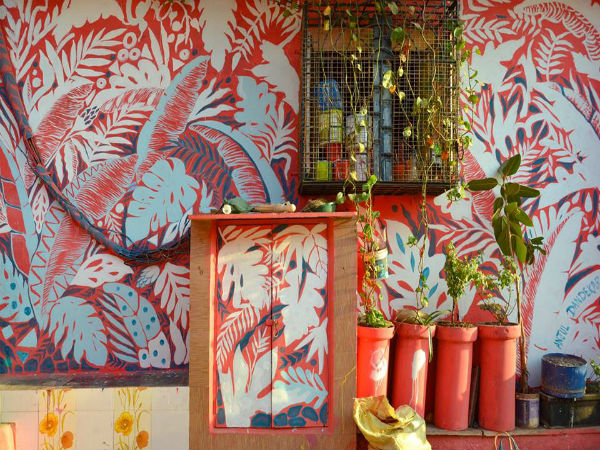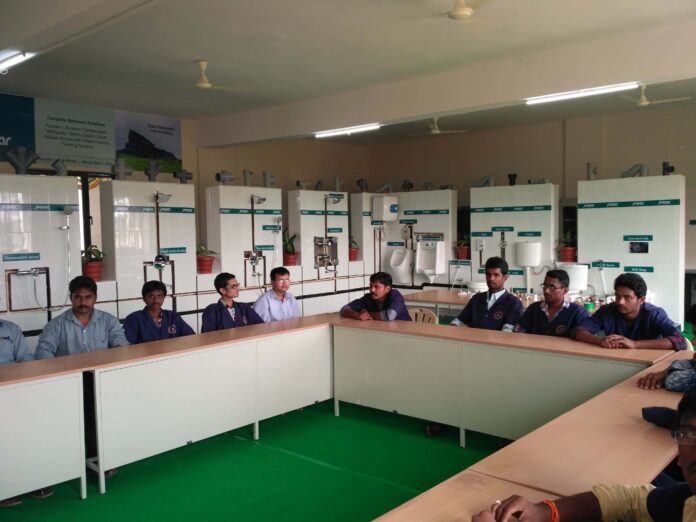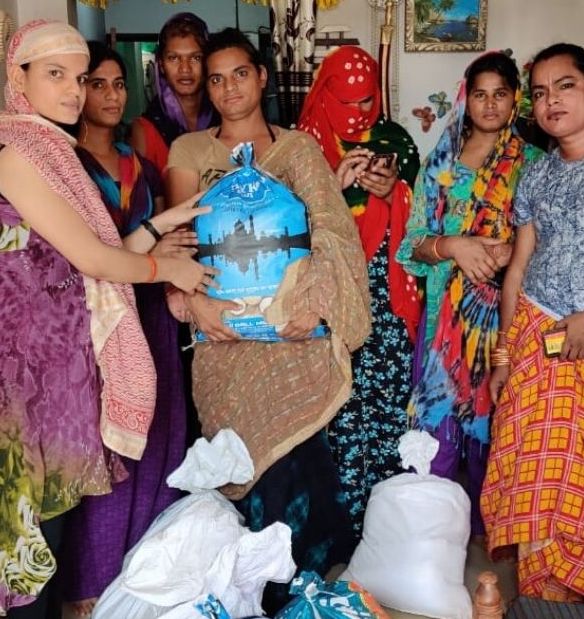CSR: Colours Uplifting The Lives Of Slum Dwellers
With the population of 2.2 Crores according to the 2011 census, Mumbai is the most populous city in India and the 4th most populous city in the world. The population has more than doubled in the last twenty years and this rapid expansion has led to the city bursting at its seams. More than 40% of the total population of Mumbai lives in it’s slums. The city is home to Dharavi, one of the largest slums in the world.
The slums are located in every part of Mumbai, clearly visible to all the commuters or tourists. When foreign nationals fly to Mumbai to explore the culture and the heritage of the city, the first sight of the city they get to see from the airplane windows is the beeline of shanties around the runway, covered in worn out blue tarpaulins.
Apart from how they look, the conditions that people live in in these slums, are an eyesore for everyone especially for those who are new in the city. These areas are hot bed for infections as they lack basic facilities to maintain any hygiene standards. The population density in slums is very high and the shared toilets are not enough to meet the needs of the local population so open defecation is a normal practice. This leads to an attitude wherein the residents have a lacklustre attitude towards cleanliness.
Chal Rang De is a Non profit organisation that partners with corporates, local councillors and residents to revamp the slum areas by painting the walls with bright colours and vibrant art. Because of this, the locals have begun to view their area with new found respect and that is where the change kicks in. Their first project in Asalpha is a roaring success and has completely changed the scenery of the area. Not only does it look great but it has become a tourist attraction, providing an additional revenue to the locals. The volunteer artists have painted the walls taking inspiration from global culture and art, exposing the local too to gain this exposure.
Inspired by the change they observed in Asalpha, the organisation kicked off their next project in a fishing community in Khardanda. This area which has around 7000 houses is cut off from modern Mumbai. The organisation has not only taken up the task of beautifying the area by painting art and murals on its walls but also providing sustainable waterproofing to about 300 houses for the rainy season.
The locals have appreciated the efforts of the organisation heartily. “The area looked very different before. It was all black and white. Now it is as if a rainbow has descended permanently on our locality,” said a local resident of Khardanda.
Thank you for reading the story until the very end. We appreciate the time you have given us. In addition, your thoughts and inputs will genuinely make a difference to us. Please do drop in a line and help us do better.
Regards,
The CSR Journal Team
Need To Update The Justice System Of India
It is rightly said that Justice delayed is equivalent to justice denied. And the justice system in India is denying justice to thousands of people in this manner.
India has one of the largest number of prisoners that are under trial. These prisoners are in jail not because they are guilty of a crime and are sentenced to jail but because the charges they face, are too severe to warrant bail, or because they are too poor or disempowered to be able to afford a bail.
The state of the mascots of justice in India is also not that good. According to the Law commission, 50 judges for a million people is a recommended standard for a judicial system to work smoothly. India currently has about 18 judges per million people. The investigation officers in India on an average handle 450 cases each. These officers are state cadres that do not have any formal training to be specialist investigators for any kinds of crime. India does not have any specialist investigators for terrorism, rapes or robberies. The same investigation officers manage all kinds of cases.
These conditions lead to a huge backdrop in the cases in court often leading the victims to not get justice till they die. Other times, the justice is granted years later when the significance of the crime has diminished or the criminal is too sick or on his deathbed, having lived his whole life in freedom without any conviction.
In terms of conviction India is not up to date. The country’s conviction laws are too outdated and are not based on any form of research. Many countries treat prisons as rehabilitation center where they attempt to change the criminals into responsible citizens. This way, after they are done serving their jail term, they can go back to civilisation and contribute to the society. This way, even if they are in jail for a long time, their caliber and talent is not wasted. In India though, all the prisoners are treated equally with not many resources available to them. The prisoners do not have many options available to them to pursue anything of their interest. And since they are not treated with any formal expertise, there is no assurance of them being any better when they return back to the society.
India really needs to buck up to strengthen its justice system. After all, access to justice for all is also one of the United Nations’ Sustainable Development Goals for 2030.
Thank you for reading the story until the very end. We appreciate the time you have given us. In addition, your thoughts and inputs will genuinely make a difference to us. Please do drop in a line and help us do better.
Regards,
The CSR Journal Team
देखें जब सड़कों पर बहा दूध
महाराष्ट्र में कीमतें बढ़ाने की मांग को लेकर दूध उत्पादक किसानों का प्रदर्शन।
सड़कों पर दूध बहाकर कर रहे है प्रदर्शन।
प्रति लीटर दूध की खरीद पर 5 रुपये बढ़ाने की कर रहे है मांग।
किसानों ने मुंबई और पुणे में आधी रात से दूध की सप्लाई कर दी है ठप।
प्रदर्शन को देखते हुए दूध की हो सकती है किल्लत।
सवाल ये कि आखिरकार कब तक सहेगा किसान, कब होगा समस्या का निराकरण।
कब तक सरकारें किसानों के मुद्दे पर रहेंगी मौन।
कब तक किसानों के मुद्दों पर होता रहेगा राजनीतिकरण?
CSR: Skilling The Youth For National Development
15th of July is marked and celebrated as World Youth Skills Day every year. Since the launch of National Youth Skill Mission in 2015, India has progressed significantly in terms of employability of youth. According to the fifth edition of the Confederation of Indian Industry’s (CII) ‘India Skills Report 2018’, the employability score has increased by 5.16 per cent this year, reaching a new level of 45.6 per cent.
In order to contribute towards national development by skilling the youth, Jaquar Group has announced the skill development and training of over 300 plumbers. The training will be imparted to these plumbers through 10 specialised training centres which are spread across India. The centres will train unemployed youth in specialised skill sets and develop them as trained plumbers.
“There is a lack of skilled workforce in plumbing in India and with the poised growth of real estate, this shortage needs to be addressed. Jaquar Group is trying in meet the need of the hour and empower today’s youth,” said Mr. Rajesh Mehra, Promoter & Director, Jaquar Group.
“Skill development is also an important initiative driven by the Government and we believe that our effort of training plumbers will support their overall vision,” He added.
As part of the programme, individuals will be imparted the skills of a trained plumber through on ground teaching and execution of mock instances. The training will be on 80-20 concept; 20% of theory & 80% of practical. It will encompass teaching on safety measures and fittings of high-tech bathing fittings including showers and wellness products. Once the training is completed, the plumbers will also be given an opportunity to be part of the organisation.
Thank you for reading the story until the very end. We appreciate the time you have given us. In addition, your thoughts and inputs will genuinely make a difference to us. Please do drop in a line and help us do better.
Regards,
The CSR Journal Team
NIO Vision Marathon to raise awareness about Avoidable Blindness
Marathons are a great way to motivate employees to take care of their health and to live a long and productive life. Employees that run have far fewer sick days off compared to non-runners.
For past four years NIO Vision Marathon has been an attempt to raise awareness about Avoidable Blindness. Dr. Aditya Kelkar and Dr. Jai Kelkar of the National Institute of Ophthalmology have been taking the lead in spreading awareness and guiding the NIO Vision Marathon Team to spread awareness about Avoidable Blindness.
Avoidable blindness can be treated/ prevented by known, cost-effective means, yet nearly 75% of the world’s blind are blind due to Avoidable Blindness. This is mostly because this category of blindness is not given proper attention and many people have not been made aware of this type of blindness yet. Because of this, NIO Vision Marathon is trying to spread awareness about the main causes of avoidable blindness, in order to have the greatest possible impact on vision loss worldwide.
NIO Vision Marathon is an opportunity for first-time runners and also for experienced marathoners. It is an experience to run in a crowd of 5,000 runners. Race lengths are 3km, 5km, 10km, 15km and Half Marathon.
Blindfolded buddy run
This is a special run where two buddies register together. The first friend runs half the distance blindfolded. At turnaround point, participants exchange the blindfold and run back.
This race is conducted under the aegis of Pune District Athletic Association; the records set during this race are recognized.
Date: July 22, 2018












